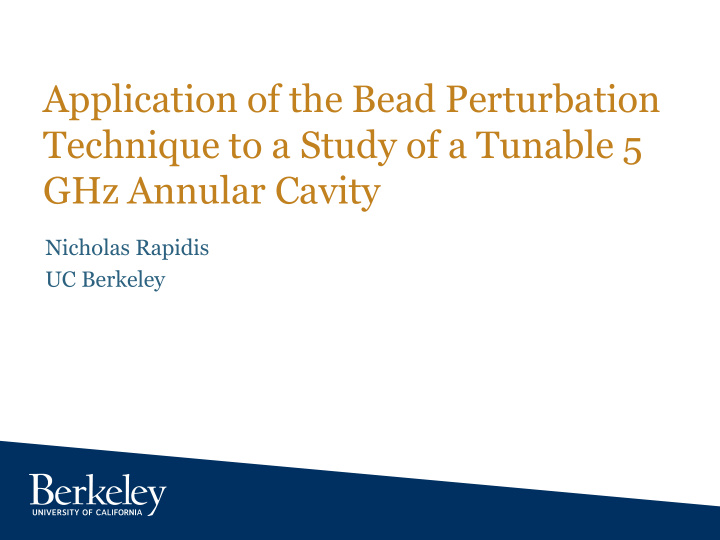



Application of the Bead Perturbation Technique to a Study of a Tunable 5 GHz Annular Cavity Nicholas Rapidis UC Berkeley
Outline • ADMX-HF brief overview • Cavity Characteristics • Cavity study at Berkeley • Future work • Conclusion and summary
Collaboration Yale University (experim iment sit site) Steve Lamoreaux, Ling Zhong, Ben Brubaker, Sid Cahn, Kelly Backes UC Berkeley Karl van Bibber, Maria Simanovskaia, Samantha Lewis, Jaben Root, Saad Al Kenany, Nicholas Rapidis, Isabella Urdinaran CU CU Boulder/JILA Konrad W. Lehnert, Daniel Palken, William F. Kindel, Maxime Malnou LLNL Gianpaolo Carosi, Tim Shokair
Experiment at Yale • Cu Cavity with off-axis tuning rod 𝑡𝑗𝑜𝑏𝑚 ∝ B 2 VQ𝐷 𝑛𝑜𝑚 • 9 T magnet P • Dilution refrigerator T~100 mK • Josephson Parametric Amplifier, tunable from 4.4-6.4 GHz • First data run (2016) in 5.75 GHz range (~24 μ eV)
Desired Cavity Characteristics • Large Volume ~2 L – 25.4 cm height – 10.2 cm diameter Use of 5.1 cm diameter copper rod • Large dynamic frequency range – 3.4 – 5.8 GHz
Desired Cavity Characteristics • High Quality factor, Q Mode−dependent constant of order 1 ∗ Volume Q ∝ Surface area ∗(Skin Depth) – Increases at lower temperature – Affected by rod position, coupling, intruder modes
Desired Cavity Characteristics • High Form Factor, C mnl (𝐲)) 2 ∗ ( d 3 𝐲 𝒜 ∙ 𝐟 mnl C mnl ≡ in our case 𝜗 𝐲 = 1 2 ∗ V d 3 𝐲 𝜗 𝐲 𝐟 mnl (𝐲)) Non-uniformities in the cavity will cause mode localization thus deteriorating the form factor
Desired Cavity Characteristics • Freedom from mode crossings
Desired Cavity Characteristics • Freedom from mode crossings
Detailed Cavity Study at Berkeley • Precision metrology on current apparatus • High Fidelity Simulations • Precision Field Mapping using Bead-Perturbation Technique
Detailed Cavity Study at Berkeley • Precision metrology on central rod – Alignment of rod axis w.r.t. tubes holding it in place in the cavity – Better understanding of mode localization when misaligned in cavity • Precision metrology on cavity – Allows for more accurate future simulations
Detailed Cavity Study at Berkeley • High Fidelity Simulations TE TM 010
Detailed Cavity Study at Berkeley
Detailed Cavity Study at Berkeley Sapphire bead ε =11.5
Detailed Cavity Study at Berkeley Precision Field Mapping using Bead- 𝐹(𝑠) 2 ∆ω ω = −(ϵ − 1) V Bead Perturbation 1/2 2 V Cavity 𝐹(𝑠) 2 technique cav
Determining mode type using bead pull TM 010 TE 050
Misalignment Measurements
Misalignment Measurements
Misalignment Measurements
Misalignment Measurements
Misalignment Measurements Each step corresponds to an angle shift of 1.5 mrad
Mode Crossings
Mode Crossings Data from TM 010 mode no longer useful when mode is within ~3 MHz of TE mode
Mode crossings Other noticeable mode crossings have no significant effect on TM 010 mode
Future work • Bead pull study on actual cavity – Determining usable/unusable frequencies and impact of intruder modes – Ultimately, in situ bead-pull for real time characterization of the cavity and mode during the run. • Full 3D mapping of cavity • Simulations confirming behavior and studying further aspects of cavity – Free frequency ranges – New designs, e.g. Photonic Band Gap Cavities
Conclusion • Can determine type of each mode in spectrum using bead pull • Good understanding of sensitivity to rod misalignments • Ability to determine strength of mode crossings and determine effect on data taking
Thank you! Questions?
Recommend
More recommend